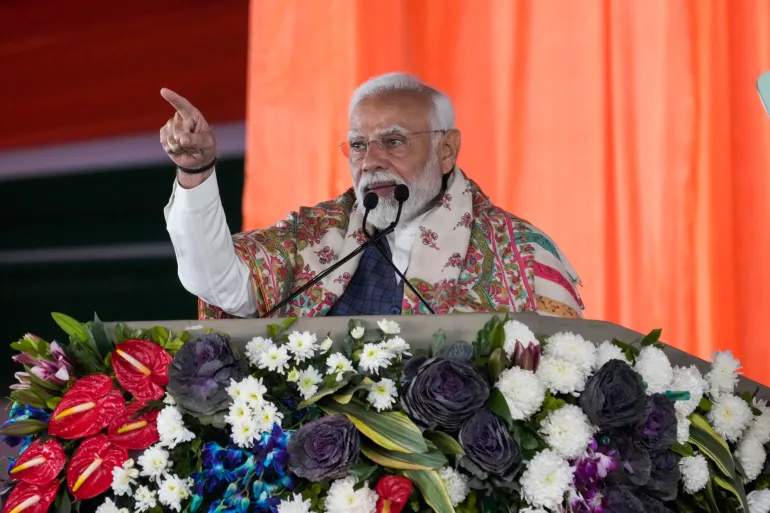Summary by Geopolist | Istanbul Center for Geopolitics:
The Foreign Policy article discusses the state of Indian democracy under Prime Minister Narendra Modi, who recently began his third term despite losing his governing majority. Here is a detailed summary:
Context and Overview
- Democracy Downgrade: International organizations like Freedom House, V-Dem Institute, and the Economist Intelligence Unit have downgraded India’s democratic status, especially since Modi’s second term started in 2019.
- Human Rights and Democracy: Modi’s tenure has seen accelerated erosion of human rights and democratic norms. Although he remains personally popular, his party, the BJP, lost significant seats in the recent elections.
Modi’s Ideological Shift
- Hindu Nationalism: Modi has shifted India’s identity from Nehru’s vision of a diverse, secular society to one dominated by Hindu nationalism.
- Youth Influence: Modi has targeted India’s youth, who largely do not remember Nehru’s era, to mold them into his vision of India.
Modi’s Governance and Image
- Economic Policies: While projecting himself as a free market advocate, Modi has continued welfare programs and maintained a neutral foreign policy. However, his tenure has seen rising unemployment and persistent corruption.
- Media Control: Modi has not held a single press conference in India as Prime Minister, preferring to communicate via controlled media, such as his radio program, “Mann Ki Baat.”
Modi’s Political History
- Gujarat Legacy: Modi’s political career began in Gujarat, where he was Chief Minister for over 12 years. His tenure there, especially the 2002 riots, is seen as a precursor to his national policies.
- Riots of 2002: The Gujarat riots in 2002, where over 1,000 people (mostly Muslims) were killed, remain a dark mark on his record, despite the Supreme Court finding insufficient evidence to prosecute him.
Recent Literature on Modi
- Christophe Jaffrelot’s Analysis: Jaffrelot’s book “Gujarat Under Modi: Laboratory of Today’s India” outlines how Modi’s governance style in Gujarat—marked by religious polarization, institutional hollowing out, and autocratic governance—has been replicated nationally.
- Surveillance and Repression: Modi’s administration has increased surveillance and used draconian laws to stifle dissent and jail political opponents, often without trial.
Key Cases and Books
- Bhima Koregaon Case: The 2018 Bhima Koregaon case, where activists and dissidents were arrested under the Unlawful Activities (Prevention) Act (UAPA), is highlighted as an example of the government’s crackdown on dissent.
- Books on Political Repression: Works like “The Incarcerations: BK-16 and the Search for Democracy in India” by Alpa Shah and “How Long Can the Moon be Caged?: Voices of Indian Political Prisoners” by Suchitra Vijayan and Francesca Recchia detail the harrowing experiences of political prisoners under Modi’s rule.
Historical and Ideological Roots
- Savarkar’s Influence: The article discusses the influence of Vinayak Savarkar, a proponent of Hindutva, on Modi’s ideology. Books like Janaki Bakhle’s “Savarkar and the Making of Hindutva” provide a nuanced view of Savarkar’s legacy and its impact on modern India.
- Hindu Nationalism Abroad: Edward Anderson’s “Hindu Nationalism in the Indian Diaspora” examines how Modi’s policies are supported by the Indian diaspora, which plays a role in promoting Hindutva internationally.
Conclusion
- Enduring Influence: Modi’s vision of India, rooted in Hindu nationalism, has left a lasting mark. Reverting to Nehruvian ideals of secularism and diversity will be challenging and will require significant effort.
The article paints a comprehensive picture of how Modi’s tenure has transformed India’s political and social landscape, highlighting the challenges to democracy and the rise of Hindu nationalism.
Read more below.
Modi’s Long Game
India has long been described as “the world’s largest democracy,” although in recent years, it has experienced significant backsliding: Freedom House, the V-Dem Institute, and the Economist Intelligence Unit have all downgraded India in their rankings, most acutely since 2019, when Prime Minister Narendra Modi began his second term. Successive Indian governments have weakened human rights, but the process has accelerated under Modi, who has held office since 2014 and limped back last month after an election that saw him lose his governing majority.
Although Modi may be wounded, he remains vastly popular personally. No other prime minister since India’s first, Jawaharlal Nehru, has won three consecutive terms. And Modi’s achievements go beyond electoral success. In the past decade, he has singularly sought to modify the Nehruvian idea of India—from a heterogeneous society where people of different religions, languages, ethnicities, and castes lived together in relative harmony, to a society rooted in Hindu nationalism with one dominant religion, one set of rules, one leader, and one ideology. Those who don’t like it can leave India, the more vociferous politicians in his Bharatiya Janata Party (BJP) say; those who oppose it may end up in jail, and minorities must accept and endure.
From early on, Modi saw India’s growing youth population as moldable. Fewer than 10 percent of today’s Indians were born before Nehru—who laid India’s foundational principles of socialism, secularism, and nonalignment—died in 1964. And under Modi, the government has destroyed physical edifices of the Nehru era, undermined norms that governed institutions, and appropriated past achievements as its own.
For his part, Modi has projected himself as a free marketeer opposed to socialism—although he has maintained, if not enhanced, preexisting welfare programs—and has little time for secularism. He speaks of a more muscular foreign policy, but he has maintained the kind of neutrality in pursuing India’s national interests that once exasperated the West. At home, he has built the image of India as a burgeoning power, with other nations lining up to access its large market, helping them in their quest to “de-risk” from China. What completes India’s marketing pitch is a vast population of young people who are eager to work.
But unemployment has been rising, and corruption has continued under the BJP—both of which partly explain Modi’s stumble. Still, even though the BJP lost 63 seats in Parliament in this year’s election, it still has more than double the number of seats of its nearest rival, the Indian National Congress.
As Modi begins his third term—the first in which he must rely on the support of coalition partners to govern—it’s worth considering whether the new restraints on his mandate will change the nature of contemporary Indian politics. A few recent books by scholars, journalists, and essayists about the prime minister and his past offer some clues. Their fascinating interpretations of Modi—where he comes from, what he has done, and where the ideas that guide him originate—suggest that he and his supporters have ensured that the ideological roots of his policies are now too ingrained in the country to be replaced. This does not augur well for Indian democracy.
People listen to the 100th episode of Modi’s radio program at a tea shop in Patna, India, on April 30, 2023. Santosh Kumar/Hindustan Times via Getty Images
Modi himself does not share much candidly. He has not given a single press conference in India as prime minister. His supporters say he speaks directly to the people, often through his radio program, called Mann Ki Baat (“Conversations From My Mind”), which helps him control the narrative through one-way communication. The few interviews that he has given are to pliant journalists who toss softball questions. Modi prefers answering nonpolitical questions, as he did during a conversation with a Bollywood actor, who asked the prime minister whether he ate mangoes—and if he did, did he cut the mangoes, or did he suck the fruit to drink the juice?
Much of Modi’s past is difficult to ascertain, in part because he has crafted a narrative that is hard to prove or disprove. For instance, he claims that he sold tea at a railway station as a child, but there is no record of this shop, and the station did not have much railroad traffic until after he left the village. He has also said that he has a master’s degree in a subject called “entire political science,” but no student or professor has come forward remembering him.
However, we do know that his political career began in the western state of Gujarat, where he served as chief minister for a little more than 12 years. Christophe Jaffrelot, a scholar of Indian politics at King’s College London and Sciences Po in Paris, argues that to understand where India is today, one must look at how Modi governed in Gujarat.
Modi’s rule will forever be marked by the 2002 riots in Gujarat, in which more than 1,000 people were killed by official count—most of them Muslims—in retaliatory violence after a train car carrying Hindu pilgrims caught fire, killing nearly 60 people. Human rights groups accused Modi’s administration of not doing enough to stop the violence; in 2012, the Indian Supreme Court accepted a report from the Special Investigation Team that said there was insufficient evidence to prosecute Modi. His supporters treated that report as a character certificate, arguing that he was exonerated. Modi became the BJP’s standard-bearer for the 2014 elections.
A Hindu mob waves swords at an opposing Muslim mob during riots in Ahmedabad, India, on March 4, 2002. Sebastian D’Souza/AFP via Getty Images
In his new book, Gujarat Under Modi: Laboratory of Today’s India, Jaffrelot describes five conditions that enabled Modi to dominate the state: electoral victories won through religious polarization; the hollowing out of institutions; support for well-connected business groups; personalized, autocratic governance; and efforts to make the aspiring middle class feel that he was their best hope.
During his leadership of the state, Modi told its residents that any attack on him was an attack on Gujarati identity. He marketed Gujarat as a business-friendly state—which it always had been—and cultivated close relationships with major corporate interests. Two Gujarati conglomerates, those of Mukesh Ambani and Gautam Adani, have grown immensely since 2002. Adani’s rocket-like rise, in particular, has paralleled Modi’s own.
Gujarat Under Modi: Laboratory of Today’s India, Christophe Jaffrelot, Oxford University Press, 416 pp., $39.99, July 2024.
But as Jaffrelot shows, the surveillance of political opponents increased under Modi’s rule, and Gujarat also saw cases of extrajudicial killings.
Jaffrelot points out how Modi has always perceived that the poor don’t vote according to their socioeconomic situation, but rather based on their identity. As a campaigner, Modi tells the poor that he is one of them, suggesting that they, too, can rise, as he did. He assures Hindus that he will protect them. For those worried about law and order, he is India’s chowkidar, or security guard, and for the devout, he is the priest. (Modi—and not a priest—officiated at the inauguration of the Rama temple in Ayodhya this year.)
However, Jaffrelot writes that Modi also made the elite and powerful feel like they were the underdogs. He painted dissidents as extremists, terrorists, or anti-Indian. Activists who defended the rights of the marginalized and the weak were called enemies of the state. Modi has repeated that playbook as prime minister, skillfully using draconian laws enacted by his predecessors to jail dissidents. In response, India’s bureaucracy, judiciary, and security establishment have often shown themselves to be pliant.
Under Modi, India has detained thousands of government critics, many of whom have yet to face trial. Given that many are arrested under anti-terrorism laws, courts have given the government considerable leeway. Investigative authorities take inordinately long to put together charges. The process is the punishment; according to a report by the Delhi-based People’s Union of Civil Liberties, almost all of those accused have been released or granted bail by the court, but often not until years after they were arrested. Such victims have no remedy; they can’t sue the state. This chills dissent.
- Students take part in a demonstration in New Delhi on July 6, 2021, after the Indian rights activist and Jesuit priest Stan Swamy died on July 5 ahead of a bail hearing. Sajjad Hussain/AFP via Getty Images
- Police escort activist and lawyer Sudha Bharadwaj (right) toward a van as she leaves jail to appear in a special court ahead of her release on bail in Mumbai, seen on Dec. 8, 2021. Punit Paranjpe/AFP via Getty Image
Nowhere is this pattern more manifest than in the case against the 16 people—activists, human rights defenders, lawyers, journalists, and others—arrested in 2018 in the so-called Bhima Koregaon conspiracy under the Unlawful Activities (Prevention) Act (UAPA), which gives the state enormous powers to designate individuals as “terrorists” and detain them. Of those arrested in what is now known as the BK-16 case, eight have since been released or granted bail; one has died while in judicial custody.
In 2018, nearly 30,000 Dalits—members of India’s lower-caste communities—gathered in Koregaon Bhima, a village in the Pune district, located not far from India’s commercial capital, Mumbai. Two hundred years earlier, the British had defeated the Maratha rulers in a famous battle there. The British army included Dalit troops; the Marathas were from an upper caste, and Dalits consider it to be a major victory in their struggle for self-respect.
The Incarcerations: BK-16 and the Search for Democracy in India, Alpa Shah, William Collins, 672 pp., $40.65, March 2024.
Violence broke out when upper-caste Hindus attacked Dalits who were celebrating the anniversary of the victory. The Pune police arrested Dalit leaders for making speeches, calling many of them “Maoists.” Arrests mounted, and those nabbed included people who were nowhere near the village. The government showed emails and other documents as evidence. Painstaking research by independent agencies abroad indicated that the evidence was planted on the hard drives of those detained using sophisticated surveillance software and spyware. Lawyers have called the proceedings unfair, while India’s national investigation agency has dismissed the allegations.
In her new book The Incarcerations, London-based social anthropologist Alpa Shah writes a harrowing account of the BK-16 case. She finds that surveillance technology, draconian laws to circumvent due process, and other efforts to stoke fear—techniques that Modi developed in Gujarat—are now implemented nationally.
Shah offers vivid portraits of those arrested. Among them were mathematician-turned-trade unionist Sudha Bharadwaj, who gave up her U.S. citizenship to work among marginalized communities in India; Stan Swamy, a Jesuit priest in his 80s who fought for Indigenous rights in eastern India and died in judicial custody in 2021; and Anand Teltumbde, an academic married to the granddaughter of the politician who is known as the father of the Indian Constitution, Babasaheb Ambedkar.
The UAPA preceded Modi’s rule, but it has now been weaponized to target dissidents and political opponents. The book How Long Can the Moon be Caged?: Voices of Indian Political Prisoners by lawyer Suchitra Vijayan and journalist Francesca Recchia meticulously compiles stories of those detained under the UAPA and similar laws since Modi came to power. Their itemization of the cases is exemplary and includes firsthand testimonies from those arrested, partly drawn from publicly available material. The book reveals the familiar pattern of Modi’s governance: politically motivated arrests, illegal searches and seizures, attempts to portray dissidents as criminals, tolerance for the spread of disinformation, and the use of the media to amplify the vilification of those arrested.
How Long Can the Moon Be Caged?: Voices of Indian Political Prisoners, Suchitra Vijayan and Francesca Recchia, Pluto Press, 216 pp., $22.95, August 2023.
Taken together with Shah’s detailed reconstruction of the stories of BK-16 detainees, Vijayan and Recchia’s methodical research offers a haunting and sobering picture of the full horror of criminalizing dissent.
As New York-based Indian writer Siddhartha Deb writes in Twilight Prisoners: The Rise of the Hindu Right and the Fall of India, Modi’s efforts to curb civil liberties in the BK-16 case and beyond are an essential part of his project to turn what was once a secular democracy into a Hindu state. Deb’s book examines the costs of this social and political transformation. He reflects on the symbols of Muslim life and culture being erased in India through changes to names of cities and roads, analyzes rising violence in India’s northeast, and critiques the Hindu right wing.
Deb writes of the cynical and selective ways in which Modi’s government has disenfranchised and isolated Muslims—how a Citizenship Amendment Act intended to offer fast-track asylum to members of religious minorities from neighboring countries, for example, excludes Muslim refugees. Although India’s middle class applauds the improved infrastructure under Modi, Deb warns that “the market was not a gateway to greater equality and democracy but a hall of mirrors distracting us from cruelties new and old pulsating through the land.”
Twilight Prisoners: The Rise of the Hindu Right and the Fall of India, Siddhartha Deb, Haymarket Books, 232 pp., $21.95, April 2024, paperback.
Importantly, Deb examines Modi’s longtime association with the Rashtriya Swayamsevak Sangh (RSS), a Hindu nationalist organization that will celebrate its centenary next year. The RSS is a militant outfit whose founders derived inspiration from Germany’s Nazis and Italy’s Fascists. (Those leaders’ books and speeches feature passages praising Adolf Hitler and Benito Mussolini.) Modi’s affiliation with the RSS—which he joined in the 1970s—can be seen in his “unmoored nihilism that dresses itself in religious colors … that is ruthlessly authoritarian in the face of diversity and dissent, and that imprints the brute force of its majoritarianism wherever it is in power,” Deb writes.
Like the RSS, moreover, Modi plays for the long term. Most politicians prepare for the next elections; the RSS wants to groom the next generation. And in that, it is succeeding.
The injured sense among Hindus that they are not getting their due is not going away. Modi and his followers identify the Muslim as the outsider. Much as he did in Gujarat, Modi will continue to characterize who oppose him as those who oppose the nation. These efforts undermine India’s liberal democratic credentials and help Modi consolidate power. Even with a weakened mandate, the only real checks against Modi will be the strength of the opposition, what remains of independent media, and the commitment of India’s judiciary to uphold the constitution.
Muslim devotees offer Friday prayers at an open ground in Gurgaon, a city on the outskirts of New Delhi, on Dec. 17, 2021, after several prayer sites were closed by the authorities following demands by right-wing Hindu groups calling for a ban on Muslim prayers in open spaces. Sajjad Hussain/AFP via Getty Images
Although the Indian economy has grown at a rapid pace in the past decade, inequality has widened. As Modi finds it difficult to meet Indians’ aspirations, it makes sense that he and his government stoke religious fires. Cultural nationalism overrides other priorities, and the BJP’s brand of exclusionary identity politics pits the privileged against the deprived. The Hindutva project that Modi believes in rests on creating new icons, such as Vinayak Savarkar, whose politics were the opposite of those of Mahatma Gandhi.
Gandhi, a devout Hindu, believed in secularism. He articulated his vision in a book called Hind Swaraj (1909), which now reads as quaintly antediluvian, with its suspicion of modernity and machinery, glorification of rural life, celebration of tradition, and spiritual underpinnings. Savarkar’s response, Essentials of Hindutva (1922) presented a muscular and militaristic vision of Hinduism. It blamed outsiders for India’s decline—Muslim invaders first and the British later. In seeking a purer India “uncontaminated” by foreign influences, Savarkar wrote that true Indians are those who identify with India as their pitrubhumi (fatherland) and their punyabhumi (holy land).
Savarkar had long championed violent opposition to colonization: In 1909, he wrote an account of the 1857 revolt against British rule in India. He admired European nationalists and had good things to say about Hitler and Nazi Germany for rebuilding a country from the ruins of World War I and inculcating national pride among the vanquished Germans. To his credit, Savarkar also opposed the caste system and was committed to empowering women.
Savarkar was active in political struggles against the British while he was in the United Kingdom to study law. In 1910, he was shipped to India to stand trial on charges of treason and abetment of murder. He escaped from the ship when it docked in France, where authorities refused his request for asylum. Once in India, he was sentenced to two life imprisonments in the remote Andaman Islands. In prison, he resented what he considered favorable treatment given to Muslim inmates. Savarkar sought release by repeatedly pleading with the British authorities, writing petitions seeking mercy. The British ultimately released him, insisting that he could not take part in political activities, and Savarkar obediently complied.
However, after his release, Savarkar wrote copiously on political and social subjects. He was angry with Gandhi over the compromises that he made to accommodate Muslims and was among the named conspirators arrested after Gandhi was assassinated in 1948, although he was acquitted for lack of sufficient evidence.
Modi pays tributes to freedom fighter Vinayak Savarkar at the Parliament House in New Delhi on May 28, 2014, to mark the 131st anniversary of his birth. Sonu Mehta/Hindustan Times via Getty Images
Modi has spoken frequently of Savarkar as a model leader and routinely paid tribute to him. Since the BJP came to power in 2014, there has been growing interest in Savarkar’s politics, including a two-part biography by Vikram Sampath, a rising star among India’s right-wing authors, and a recent biopic that performed poorly at the box office. Those accounts present an airbrushed view of Savarkar.
Fortunately, there is now a biography that treats Savarkar with the seriousness that his life deserves while also looking at him critically. In Savarkar and the Making of Hindutva, Janaki Bakhle deeply examines his life, including reading his texts—both prose and poetry—in the original Marathi language. Bakhle, a historian at the University of California, Berkeley, offers a nuanced understanding of the mind of Savarkar, who she sees as both a social reformer and a revolutionary who was a demagogue in handling the Muslim question. She dissects him clinically, pointing out his progressive thoughts as well as the danger that his prejudices represented.
Savarkar and the Making of Hindutva, Janaki Bakhle, Princeton University Press, 520 pp., $35, February 2024.
Bakhle also describes a continuum between Savarkar’s thinking and the BJP’s Hindu nationalist ideology. She calls his tract on Hindutva a celebration of the Indian territorial nation—an idea from which exclusionary Hindu nationalism emanates. Savarkar lived in colonized India, but he was more obsessed with Muslims than the British, she writes. In Savarkar’s view, there were only three types of Muslims: those who demanded and got special favors; those who were violent; and those who weakened Hindus by subjugating them, referring to the period when Muslim rulers controlled Delhi, from the 12th century to the 1850s. Importantly, when Savarkar put these ideas on paper, there was a receptive audience.
Like many adherents of Hindutva, Modi has found inspiration in Savarkar’s writing and worldview. As Bakhle shows, Savarkar’s views did not have room for those who had different faiths or did not subscribe to his vision of Indian nationhood. Such thinking resonates with Modi and many of his followers, who feel that India took the wrong path in 1947, when it embraced Gandhi’s nonviolence and Nehru’s global outlook. Elevating Savarkar as an icon of modern India is part of the larger project of rebuilding India.
In this, the role of the Indian diaspora cannot be forgotten. As the British academic Edward Anderson argues in Hindu Nationalism in the Indian Diaspora, these lessons are being imparted to younger Hindus outside India. Whether it is British Hindus opposing laws that would make caste discrimination illegal, or Hindus in the United States claiming that there is widespread “Hinduphobia,”—which some say is partly to shut down criticism of Modi’s government—members of the Hindu diaspora have done their part to create an exclusionary identity.
As Anderson shows, many of the groups that support this agenda are intertwined with Hindutva networks in India and tend to support—financially and otherwise—Modi, the BJP, and the RSS. Modi understands this—on his trips overseas, he never misses the opportunity to flatter the Indian diaspora.
Modi is the sum of many parts: His supporters see his image as a solid edifice, while many of his critics see it as a hologram projected to astonish Indians. The tactic worked in Gujarat, and then on the rest of the country. Whether he can continue to treat dissidents with the disdain that he has shown so far remains to be seen.
Elections come and go, and Modi has already left his mark. Undoing what that has done—to revive the Nehruvian idea of India to make it syncretic once again—will take a long time.
By: Salil Tripathi
Source: Foreign Policy

















